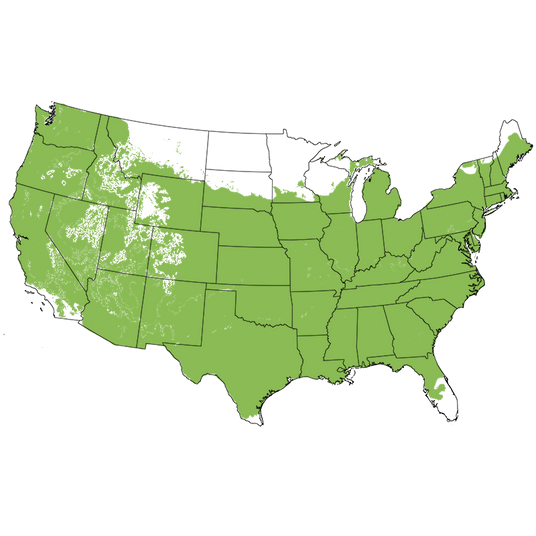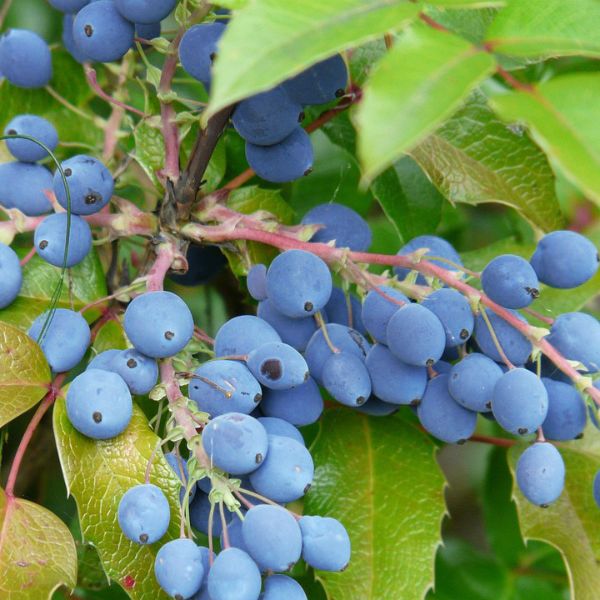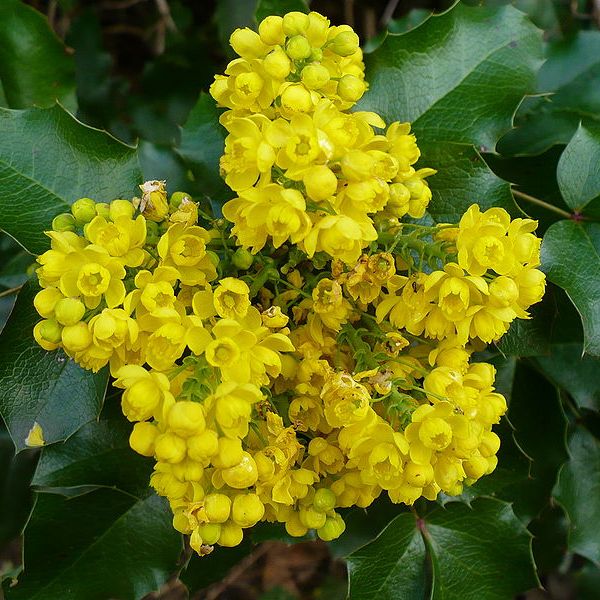Oregon Grape Holly
Mahonia aquifolium
Plant Sentry™
Plant Sentry™

Plant Sentry™ Protected
Your order is protected by our compliance system that:
- Prevents restricted plants from shipping to your state
- Ensures plants meet your state's agricultural requirements
- Protects gardens from invasive pests and diseases
Delivery and Shipping
Delivery and Shipping
Delivery and Shipping
Fast, Safe Plant Delivery
Ships in 3-4 business days • Tracking provided • Weather protected
| Under $50 | $9.99 |
| $50 - $99.99 | $14.99 |
| $100 - $149.99 | $16.99 |
| $150 - $198.99 | $24.99 |
| $199+ | FREE |
✓ Zone-specific timing • ✓ Professional packaging • ✓ Health guarantee
Understanding Plant Options
Nature Hills offers plants in two main formats:
- Container Plants: Grown in pots with soil, sized by container volume and plant age
- Bare Root Plants: Dormant plants without soil, sized by height measurements
Container Plant Sizes
Container sizes indicate plant age and growing capacity rather than liquid volume equivalents. Our containers follow industry-standard nursery "trade gallon" specifications, which differ from standard liquid gallon measurements.
Young Plants (6 months to 18 months old)
| Container Size | Actual Volume | Metric Equivalent |
|---|---|---|
| 2" x 2" x 3" | 0.18 - 0.21 dry quarts | 0.20 - 0.23 dry liters |
| 4" Container | 0.31 - 0.87 dry quarts | 0.35 - 0.96 dry liters |
| 4.5" Container | 0.65 dry quarts | 0.72 dry liters |
| 6" Container | 1.4 dry quarts | 1.59 dry liters |
| 1 Quart | 1 dry quart | 1.1 dry liters |
| 5.5" Container | 1.89 dry quarts | 2.08 dry liters |
Established Plants (18 months to 2.5 years old)
| Container Size | Actual Volume | Metric Equivalent |
|---|---|---|
| 2 Quart | 2 dry quarts | 2.2 dry liters |
| #1 Container | 2.26 - 3.73 dry quarts | 2.49 - 4.11 dry liters |
| 5" x 5" x 12" | 3.5 - 4.3 dry quarts | 3.85 - 4.74 dry liters |
Mature Plants (2-4 years old)
| Container Size | Actual Volume | Metric Equivalent |
|---|---|---|
| #2 Container | 1.19 - 1.76 dry gallons | 5.24 - 7.75 dry liters |
| #3 Container | 2.15 - 2.76 dry gallons | 8.14 - 12.16 dry liters |
Large Plants (3-5 years old)
| Container Size | Actual Volume | Metric Equivalent |
|---|---|---|
| #5 Container | 2.92 - 4.62 dry gallons | 12.86 - 20.35 dry liters |
| #6 Container | 5.25 - 6.01 dry gallons | 23.12 - 26.42 dry liters |
| #7 Container | 5.98 - 6.53 dry gallons | 26.34 - 28.76 dry liters |
Bare Root Plants
Bare root plants are sold by height from the root system to the top of the plant. Plants may exceed minimum height requirements.
Common Sizes:
- Trees: 1 foot, 2 feet, 3 feet, 4 feet, 5 feet, 6 feet
- Shrubs & Perennials: 1 foot, 18 inches, 2 feet
Important Notes
Container Volume Specifications
- Trade Gallon Standard: Our containers follow industry-standard "trade gallon" specifications established by the American National Standards Institute (ANSI Z60.1) for nursery stock
- Volume Variations: Actual soil volume may vary due to plant root systems and growing medium settlement
- Age Indicators: Container size primarily indicates plant age and maturity rather than liquid volume equivalents
Growing Conditions
- Plant size can vary based on variety and growing conditions
- Container size helps indicate plant maturity and establishment level
- Larger containers generally mean more established root systems and faster landscape establishment
Seasonal Availability
- Bare root plants are available seasonally when dormant
- Container plants are available throughout the growing season
- Specific varieties may have limited availability in certain sizes
Questions?
For questions about specific plant sizes or availability, please contact our plant experts who can help you choose the right size for your landscape needs.

Plant Sentry™ Protected
Your order is protected by our compliance system that:
- Prevents restricted plants from shipping to your state
- Ensures plants meet your state's agricultural requirements
- Protects gardens from invasive pests and diseases
Plant Profile & Growing Essentials
Evergreen, Flowering, Attracts pollinators, Disease resistant, Deer-resistant, and Self-pollinating
Specifications
Specifications
-
Botanical Name
-
Height
-
Width
-
Growing Zones
-
Sunlight
-
Growth RateModerate
-
Flower Color
-
Leaf Color
-
Fall Color
-
NativeYes
-
Pollinator FriendlyYes
-
Pollinator Required
-
FragrantYes
-
Bloom PeriodLate Spring
Planting & Care
Planting & Care
Showy ornamental native! Looking for an easy-care understory plant to meander throughout your landscape? Then try the outstanding, carefree native Oregon Grape Holly (Mahonia aquifolium, or more recently referred to as Berberis aquifolium) to bring edible ornamental charm to your landscape, along with a lot of local birds and butterflies!
Highly ornamental, canary-yellow flower clusters cover Oregon Grape Holly in spring. These massive clusters of vivid yellow spring flowers develop into picturesque dark blue berries by late summer. The berries feature a steely blue, glaucous overcast, and are held along long, downturned racemes for unmatched beauty.
Harvest the tart berries for jellies, jams, wine and more, but hurry! You'll have to beat the birds, who are hungry for their share, too. But this great native shrub isn't a Grape and it's not a Holly! Oregon Grape Holly is one of those plants that can be either the supporting actor in the garden or the star player!
The foliage is its outstanding feature and it will glow for you all season, starting with the bronze-red coloring of spring leaves that turn deep green and then mellow into a rich burgundy purple in the fall. Oregon Grape Holly is a broad-leaved evergreen that works hard all year long! This easy-care plant gives so much visual interest and is just 'tough as nails'.
Synonymous with Berberis aquifolium, this beautiful and useful native shrub is a valuable plant to western states but will grow all over the United States in Zones 5-9 with proper care. This member of the Barberry family has many nicknames, including Holly-leaved Barberry, Holly leaf Oregon Grape, and Grape Holly.
Planting and Application:
Use Oregon Grape Holly as a colorful specimen to accent your foundation planting. You can keep it small with yearly pruning or let it grow to its full 3-6 feet height and 3-5 foot spread for windbreaks, shelterbelts, and hedgerows. Pair it with its smaller sibling the Compact Oregon Grape Holly for a multi-dimensional mixed-shrub hedge. Plant it at least 4 feet from sidewalks to avoid having the shiny, spiny leaves snagging clothes.
Plant them in large containers as a fabulous way to decorate your yard. Place two plants in the same container or use two containers near each other for cross-pollination. Try flanking an entryway or gate with one placed on either side.
Easily create a Pollinator or Wildlife Garden just by adding several Oregon Grape Hollies. You'll increase berry production by planting two or more for pollination. They can blend into existing plantings and fill in odd gaps in your naturalized shady spaces.
Plant groupings or rows for year-round privacy and property division 3 feet apart on center to create a dynamic barrier and screen along the patio or to hide from the nosy neighbor. These double-duty edible landscaping shrubs are sure to please both sides of the living fence! The foliage and erect stems bring some formality, but the irregular overall shape reads as an informal, free-form sculpture. No wonder people love it as a specimen in Japanese Gardens!
Give them space and watch as it slowly spreads to create living walls of an outdoor Meditation Garden room. You'll love studying the juxtaposition between shiny, spiky dark green leaves and rounded, blue orbs of berries.
Use it in narrow side yards or plant them right up against fences or buildings. Squeeze a few between your garage and your neighbor's wall. No matter how you use this decorative plant in your landscape, your local birds and butterflies will thank you!
This plant is quite often used in shady Woodland Gardens, where it performs as a beautiful understory plant. Use them to define points along a trail in the shade of taller trees.
- State Flower of Oregon & Native to Western North America
- Year-Round Interest Broad-Leaf Evergreen Shrub
- Fragrant Bright Yellow Flowers
- Edible Berries for Jellies and Preserves
- Bronze-Red New Spring Leaves
- Glossy, Dark Green Summer Leaves
- Purple-Burgundy Fall & Winter Foliage
- Birds, Hummingbirds & Butterflies Love It!
#ProPlantTips for Care:
Oregon Grape Holly grows naturally as an understory plant in Pine and Fir forests, so likes slightly acidic soil and partial shade to full shade conditions. However, you will have far more flowers and fruit in more sun. Plant in a location that has a lower pH to avoid leaf scorch. Fertilize with acid lovers fertilizer twice a year to maintain soil acidity. Apply it once in the late winter and once in the mid-summer. This plant will also tolerate hotter, dry climates if the pH of the soil is kept below 6.5 and the plant is given regular water. Typically leaf scorch will appear if the pH is too high in either sun or shade.
Protect the lovely broadleaf evergreen leaves from the drying winds of cold winters, especially in Zones 5 and 6. Give it a protected spot - but if you can't, try using an anti-desiccant spray starting in the fall and reapply according to directions.
Very little maintenance is needed to keep this plant looking great. It is virtually disease and pest free. Deer don't like the prickly leaves and will leave them alone unless they are really hungry. It's always a good idea to use 3-4 inches of arborist mulch to cover the root system.
This is not a plant like Privet that you can simply shear with uniform tip pruning. Instead, prune Oregon Grape Holly for size control by carefully trimming the longest canes back to a leaflet pair growing below the surface of the canopy. For the best look, take your time while pruning. Layer staggered cuts evenly across the plant, hiding the cuts back into the canopy as you go.
This glossy plant should perform beautifully for you. Open it up to the sunlight and air circulation by cutting interior canes down to the ground to rejuvenate the plant every 3-5 years. You can also rejuvenate older shrubs by cutting all the way to the ground. Young stems will grow back from the center of the root system. It won't take long for the canes to grow back again, better than ever.
The flowers are hermaphroditic, and can either be self-pollinated or insect-pollinated. A nice idea to plant in groups of 3 to ensure better pollination.
- Grows in Partial Shade or Full Shade
- Moderate Moisture Needs
- Any Acidic Well-Drained Soil
- Prune After Flowering & Renewal Prune 3-5 Years
- Pest & Disease Free
- Deer Don't Prefer It
Oregon Grape Holly is one of the most admired plants for garden use. Is it possible for a plant to be both subtle and eye-catching, graceful and spiky, muted and colorful? Yes, yes, and yes! Oregon Grape Holly is all of this, and more! This highly ornamental plant is underused in many places across the country. Start a trend and order at least two of these beauties from NatureHills.com today!
Nature Hills uses Plant Sentry™ to block shipments of regulated plant materials. As one of the oldest online plant nurseries selling coast to coast, our core value is to always protect your community from invasive plants. Plant Sentry™ prevents the sale and shipment of all of our plants to any state that restricts them - so you simply will not be able to purchase any plant from us if your state prohibits them automatically.











